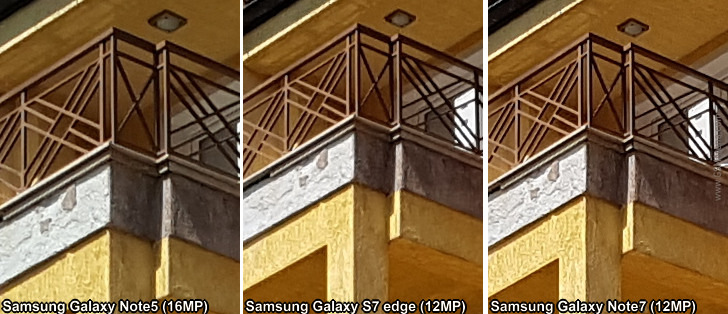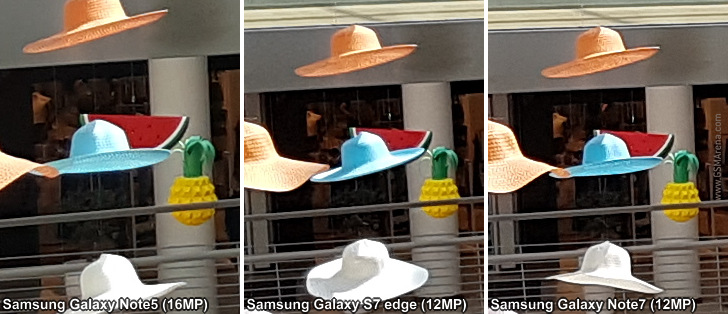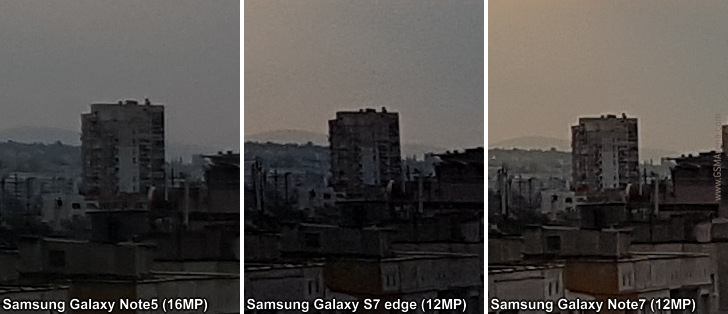Galaxy Note7 vs. S7 edge vs. Note5: Camera shootout
Camera shootout

Daylight
Snapping photos in broad daylight is the easiest scenario for any digital camera, and it presents the most common use of the smartphone camera. That's why we'll be doing the most analysis on this scenario.

The Samsung Galaxy Note7 and Galaxy S7 edge rely on the same 12MP camera sensor (4:3 aspect ratio) with the impressive Dual Pixel autofocus tech. It's faster and more accurate than any other system that came before it. It also packs Optical Image Stabilization for better low-light performance (helped by the bright f/1.7 aperture) and reducing handshake in videos.
The Galaxy Note5, on the other hand, offers a higher-res 16MP camera with 16:9 aspect ratio, OIS-enabled, too. Its aperture is f/1.9 and instead of the new Dual Pixel tech the Note5 relies on a regular phase-detection autofocus, so the 7-series has and advantage here.
Before we start putting samples against each other, we should check out the Field of View (FoV) for each camera - that determines how much of the scene fits into the frame. While the Galaxy Note5's camera is wider and with higher resolution, the Galaxy Note7 and S7 edge are the clear winners here. The 7-series may lose a tiny portion on the sides, but there is a significant gain in field of view around the top and bottom.

Test #1: Daylight photo
All three Galaxies resolve great amount of detail in board daylight and are pretty much equal in this scene. The foliage isn't perfect, but it's above average as we've seen much worse on other flagships.

The most noticeable difference is with the sharpening - the Galaxy Note5 does the least sharpening, while the Note7 applies the most. The Galaxy S7 edge is in between the Notes.
The noise levels are kept amazingly low on all three phones.
The white balance seems fine, too, but looking more closely reveals the Galaxy Note5 produces the warmest photos while the Note7 has the coolest-looking ones. The S7 edge is once again in between. The difference isn't that obvious even at the full-resolution crops, but it's worth mentioning.

And these are the untouched photos we've used for the crops.



Galaxy Note5 • Galaxy S7 edge • Galaxy Note7
Test #2: Fine texture detail
Moving on to our next scene, the Samsung Galaxy Note5 is again a little softer than the Galaxy S7 edge and Note7 images. The Note5 managed to capture more of the concrete and stucco texture on the wall than the Galaxy S7 edge, and a whisker less than the Note7. On the other hand, the Note5 image looks better as it isn't as over-sharpened as the Note7's.
There is also an obvious difference in the processing, but we'll talk about that in a moment.

No matter which Galaxy we choose, the fine texture detail will be always on top-notch levels and that's what really matters. The most prominent texture might be visible on the Note7 due to the sharpening, but we still like the more natural looking image by the Note5 better.
These are the samples we've used for this scene.



Galaxy Note5 • Galaxy S7 edge • Galaxy Note7
Test #3: Oversharpening halos
Here's a close-up of thin, black wires against bright sky. That's the worst case scenario for software sharpening as it creates the most visible halos. We upscaled each image 5 times using the 'nearest neighbor' interpolation method to make the differences clearer.
Doing this allows us to compare the amount of visible sharpening applied by each camera - in the Note7 sharpening is dialed high up, while it's moderate on the Note5 and S7 edge. The Note5 is the most gentle when applying sharpening among the three.
Pro tip: Pay attention to the white halos that follow the black lines - these are the sharpening artifacts.

You can also check these full-res crops - look at the fuse boxes at the bottom right corner. The Note7 oversharpening is quite prominent, the S7 edge does it as well but not that aggressively, followed by the Note5 at just moderate sharpening levels.

These are the samples we've used.



Galaxy Note5 • Galaxy S7 edge • Galaxy Note7
Test #4: Color rendering
Don't get fooled by the punchy AMOLED screens on those Galaxies. The color rendition of the photos turned out rather neutral, strengthened by the great contrast, high-dynamic range, and low noise levels. The Samsung's flagships have been among the few smartphones to be able to resolve the red color accurately and we've always appreciated that.
You can refer to the previous crop once again for the red color in the billboard.
Removing all other factors from the equation, the color rendering by the three cameras is the same and even better - it's very accurate. We chose two scenes full of color and the three crops perfectly demonstrate the color rendition parity.


And here are the full-res samples.






Galaxy Note5 • Galaxy S7 edge • Galaxy Note7
Test #5: Dynamic Range
In our Galaxy Note7 review we found out that the dynamic range was improved compared to the previous gen phones as the shadows of its photos were noticeably brighter than what we've used to see with the S7 series. It seems the improvement is most noticeable in the shadows, and there is none in the highlights. Our best guess is that the improved effective dynamic range is courtesy of a new processing, a dynamic range optimizer, which detects the high contrasty light conditions and brightness up the shadows by applying a special tonal curve.
Dynamic range optimization algorithms are like an AutoHDR mode, which is always on, but kicking in only when needed. Disregarding any discussion about whether that may be considered cheating or not in a way, we'll only say we're quite happy with the results. The photos look natural, and nothing is overexaggerated. We're only left wondering, why not update the S7 and the S7 edge with the same mode since they use the same image sensor.

In this sunset scene we used for testing this you can notice the gradual improvement in the shadows detail as you go from the Note 5 to the Note 7. The latest processing developed by Samsung for the Note7 made the whole scene a lot brighter than its predecessors and you can clearly see what's in the shadows.
So, when it comes to dynamic range - the Note7 clearly has the widest one - it's as if it has AutoHDR always on (and it doesn't - we checked). Turning any of the HDR modes yields even bettеr results.
These are the untouched samples.



Galaxy Note5 • Galaxy S7 edge • Galaxy Note7
Winner: Galaxy Note7. All three phones are equally good in taking daylight photos. The Galaxy Note7, however, offers the widest effective dynamic range in tough light conditions.
Reader comments
- Malik
- 02 Mar 2025
- XBp
S7 edge is the best
- the samsung tech guy
- 24 Oct 2018
- T7x
note 7 is 5.7 inch and s8+is 6.2 inch
- Anonymous
- 19 Apr 2017
- 75G
The S8+ has a 6.1 or 6.2 size screen so if I'm not mistaking it is bigger than the note7.. I'm a note fan and I ordered the s8+.